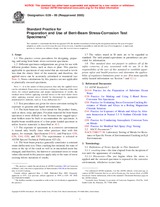We need your consent to use the individual data so that you can see information about your interests, among other things. Click "OK" to give your consent.
ASTM G39-99(2005)
Standard Practice for Preparation and Use of Bent-Beam Stress-Corrosion Test Specimens
STANDARD published on 1.5.2005
The information about the standard:
Designation standards: ASTM G39-99(2005)
Note: WITHDRAWN
Publication date standards: 1.5.2005
SKU: NS-57666
The number of pages: 8
Approximate weight : 24 g (0.05 lbs)
Country: American technical standard
Category: Technical standards ASTM
Annotation of standard text ASTM G39-99(2005) :
Keywords:
bent-beam, constant deformation, constant load, elastic strain, quantitative stress, stress-corrosion cracking, stress-corrosion test specimen, ICS Number Code 77.040.10 (Mechanical testing of metals), 77.060 (Corrosion of metals)
Additional information
| Significance and Use | ||||||||||||||
|
The bent-beam specimen is designed for determining the stress-corrosion behavior of alloy sheets and plates in a variety of environments. The bent-beam specimens are designed for testing at stress levels below the elastic limit of the alloy. For testing in the plastic range, U-bend specimens should be employed (see Practice G 30). Although it is possible to stress bent-beam specimens into the plastic range, the stress level cannot be calculated for plastically-stressed three- and four-point loaded specimens as well as the double-beam specimens. Therefore, the use of bent-beam specimens in the plastic range is not recommended for general use. |
||||||||||||||
| 1. Scope | ||||||||||||||
|
1.1 This practice covers procedures for designing, preparing, and using bent-beam stress-corrosion specimens. 1.2 Different specimen configurations are given for use with different product forms, such as sheet or plate. This practice applicable to specimens of any metal that are stressed to levels less than the elastic limit of the material, and therefore, the applied stress can be accurately calculated or measured (see Note 0). Stress calculations by this practice are not applicable to plastically stressed specimens. It is the nature of these practices that only the applied stress can be calculated. Since stress-corrosion cracking is a function of the total stress, for critical applications and proper interpretation of results, the residual stress (before applying external stress) or the total elastic stress (after applying external stress) should be determined by appropriate nondestructive methods, such as X-ray diffraction (). 1.3 Test procedures are given for stress-corrosion testing by exposure to gaseous and liquid environments. 1.4 The bent-beam test is best suited for flat product forms, such as sheet, strip, and plate. For plate material the bent-beam specimen is more difficult to use because more rugged specimen holders must be built to accommodate the specimens. A double-beam modification of a four-point loaded specimen to utilize heavier materials is described in . 1.5 The exposure of specimens in a corrosive environment is treated only briefly since other practices deal with this aspect, for example, Specification D 1141, and Practices G 30, G 36, G 44, G 50, and G 85. The experimenter is referred to ASTM Special Technical Publication 425 (). 1.6 The bent-beam practice generally constitutes a constant strain (deflection) test. Once cracking has initiated, the state of stress at the tip of the crack as well as in uncracked areas has changed, and therefore, the known or calculated stress or strain values discussed in this practice apply only to the state of stress existing before initiation of cracks. 1.7 The values stated in SI units are to be regarded as standard. The inch-pound equivalents in parentheses are provided for information. This standard does not purport to address all of the safety concerns, if any, associated with its use. It is the responsibility of the user of this standard to establish appropriate safety and health practices and determine the applicability of regulatory limitations prior to use. (For more specific safety hazard information see Section and .) |
||||||||||||||
| 2. Referenced Documents | ||||||||||||||
|
We recommend:
Technical standards updating
Do you want to make sure you use only the valid technical standards?
We can offer you a solution which will provide you a monthly overview concerning the updating of standards which you use.
Would you like to know more? Look at this page.




 Cookies
Cookies
